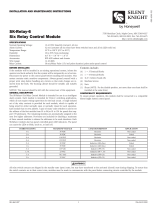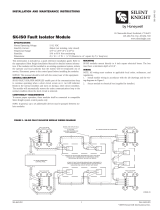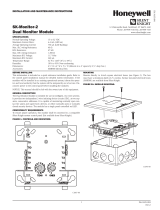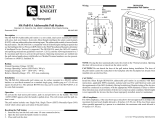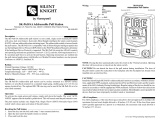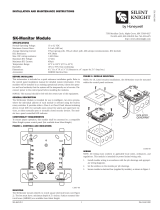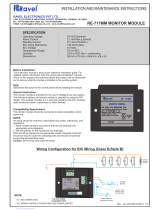Page is loading ...

SK-460-008 1 I56-3441-000
INSTALLATION AND MAINTENANCE INSTRUCTIONS
I56-3441-000
7550 Meridian Circle, Maple Grove, MN 55369-4927
763.493.6455, 800.328.0103; Fax: 763.493.6475
http://www.silentknight.com
SK-Zone-6
Six Zone Interface Module
SPECIFICATIONS
Normal Operating Voltage: 15-32 VDC
Stand-By Current: 2 mA
Alarm Current: 40 mA (assumes all six LEDs solid on)
Temperature Range: 32ºF to 120ºF ( 0ºC to 49ºC)
Humidity: 10 to 93% Non-condensing
Dimensions: 6.8˝ H x 5.8˝ W x 1.0˝ D
Accessories: IDP-ACB Cabinet and chassis
Wire Gauge: 12-18 AWG
Max. IDC Wiring Resistance: 25 ohms
External Power Supply Voltage: Regulated 24VDC
Ripple Voltage: 0.1 volts RMS maximum
IDC: (Supervised and power limited)
DC Voltage: 18-28 volts power limited
Frequency: DC
Current: 90mA per circuit
BEFORE INSTALLING
If the modules will be installed in an existing operational system, inform the
operator and local authority that the system will be temporarily out of service.
Disconnect the power to the control panel before installing the modules. This
system contains static sensitive components. Always ground yourself with a
proper wrist strap before handling any circuits so that static charges are re-
moved from the body. The module housing should also be grounded.
NOTICE: This manual should be left with the owner/user of this equipment.
GENERAL DESCRIPTION
The SK-Zone-6 Six Zone Interface Module is intended for use in an intelli-
gent alarm system. Each module provides an interface between the intelligent
alarm system and a conventional alarm system loop. A common SLC input is
used for all modules, and the initiating device loops share a common super-
visory supply and ground. Otherwise, each monitor operates independently
from the others. Each module has its own unique address.
A pair of rotary code switches is used to set the address of the first module
from 01 to 94 (or 01 to 154 for panels that support 159 addresses). The re-
maining modules are automatically assigned to the next five higher addresses.
Provisions are included for disabling a maximum of two unused modules to
release the addresses to be used elsewhere. Each module also has panel con-
trolled bicolor LED indicators. The panel can cause the LEDs to blink, latch
on, or latch off.
DET.
MODEL
COMP. ID DETECTOR
MANUFACTURER
BASE MODEL MAX
DET.
1151 A SYSTEM SENSOR B110LP, B401 20
1451 A SYSTEM SENSOR B401, B401B 20
1451DH A SYSTEM SENSOR DH400 20
2151 A SYSTEM SENSOR B110LP, B401 20
2451 A SYSTEM SENSOR DH400, B401B,
B401
20
2451TH A SYSTEM SENSOR B401, B401B 20
5451 A SYSTEM SENSOR B401 20
1100 A SYSTEM SENSOR N/A 20
1400 A SYSTEM SENSOR N/A 20
**2100AT A SYSTEM SENSOR N/A 20
2100B A SYSTEM SENSOR N/A 20
2100D A SYSTEM SENSOR N/A 20
2100S A SYSTEM SENSOR N/A 20
2100TB A SYSTEM SENSOR N/A 20
2100TD A SYSTEM SENSOR N/A 20
2100TS A SYSTEM SENSOR N/A 20
2300B A SYSTEM SENSOR N/A 20
2300TB A SYSTEM SENSOR N/A 20
2400 A SYSTEM SENSOR N/A 20
2400TH A SYSTEM SENSOR N/A 20
*2W-B A SYSTEM SENSOR N/A 20
*2W-TB A SYSTEM SENSOR N/A 20
DH100LP A SYSTEM SENSOR N/A 20
*Class B, Style B only; **No Accessory will be supported by 2100AT
COMPATIBLE TWO-WIRE SYSTEM SENSOR SMOKE DETECTORS FOR
USE WITH SK-ZONE-6 WITH ZONE IDENTIFIER A
INCLUDED:
(5) 1 x 4 Terminal Blocks (2) 11/4˝ Stand offs (3) Shunts
(4) Machine Screws (1) Long Power Supply Jumper
(2) Nuts
(6) 3.9k Ohm
End of Line Resistors
SHIPPED ON BOARD:
(2) Shunts in Class A/B position
(Shipped in Class B position, remove shunts for Class A)

SK-460-008 2 I56-3441-000
COMPATIBILITY REQUIREMENTS
To ensure proper operation, this module shall be connected to a compatible
Silent Knight system control panel (list available from Silent Knight).
COMPONENTS
The following is a description of the SK-Zone-6 mounting framework:
One or two SK-Zone-6 modules can be installed in a IDP-ACB cabinet•
The IDP-ACB cabinet has a built-in chassis that will accommodate one or two
SK-Zone-6 modules. For cabinet dimensions refer to the IDP-ACB instruction
manual.
The front SK-Zone-6 module positions of each chassis are offset below the rear
SK-Zone-6 module positions so that all of the status indicators are visible.
INSTALLATION STEPS
1. Cabinet Mounting
In a clean, dry area, mount the backbox using the four holes provided •
in the back surface of the cabinet (Figure 2).
0
1
2
3
4
5
6
7
8
9
0
7
8
6
5
4
3
2
1
9
10
11
12
13
14
15
BASE ADDRESS
ADDRESS
DISABLE
0
1
2
3
4
5
6
7
8
9
0
7
8
6
5
4
3
2
1
9
BASE ADDRESS
ADDRESS
DISABLE
10
11
12
13
14
15
C0234-05
FIGURE 1: IDP-ACB CABINET
BACKBOX
MOUNTING
HOLES
C0235-00
FIGURE 2: TYPICAL MOUNTING HOLE LOCATIONS
2. Module Installation
There are two methods for installing a module in the rear position
of a chassis. Method one is for installation of a rear module only,
when no module will be installed in front of it. Refer to Figure 3 for
instructions. Method two is for installation of a rear module when
another module will be installed in the chassis position in front of
it. Refer to Figures 4a and 4b for method two. All necessary screws
and standoffs are supplied with the modules.
2
3
1
C0237-00
C0225-00
FIGURE 3: INSTALLATION OF REAR MODULE ONLY, METHOD ONE
Step 1: Insert the bottom of the SK-Zone-6 module down into a rear slot on
the chassis.
Step 2: Carefully swing the upper edge of the board back towards the back of
the chassis until it touches the two standoffs.
Step 3: Align two 4-40 screws with the two standoffs and tighten.
Step 4: Address and wire the modules according to the instructions in this
manual.
The steps in Figures 4a and 4b describe and illustrate module installation
when the rear chassis position and the position in front of it will be filled.
Front position installation is possible only if the rear position is filled with a
module.
1
FIGURE 4A: INSTALLATION OF SK-ZONE-6 MODULE IN A REAR CHAS-
SIS POSITION, METHOD TWO
Step 1: Insert the bottom edge of the SK-Zone-6 module down into a rear slot
of the chassis.
Step 2: Carefully swing the upper edge of the board towards the back of the
chassis until it touches the short standoff attached to the chassis.
Step 3: Align the long standoff with the short standoff and tighten.
2
3
1
C0225-00
FIGURE 4B: INSTALLATION OF SK-ZONE-6 MODULE IN FRONT
CHASSIS POSITION
Step 1: Insert the bottom edge of the SK-Zone-6 module down into a front
slot of the chassis.
Step 2: Carefully swing the upper edge of the board
towards the back of the chassis until it touches the 11/4˝ (31.75mm)
standoffs installed on the rear module.
Step 3: Align two 4-40 screws with the two standoffs and tighten.
Step 4: Address and wire the modules according to the instructions in this
manual.
WIRING
NOTE: All wiring must conform to applicable local codes, ordinances, and
regulations.
1. Install module wiring in accordance with the job drawings and appropri-
ate wiring diagrams.
2. All wiring to the SK-Zone-6 is done via terminal blocks. In order to prop-
erly make electrical connections strip approximately 1/4˝ of insulation
from the end of wire, sliding the bare end of the wire under the clamping
plate screw.
3. Set the address on the modules per the job drawing. Use the rotary code
switches to set the address of the first module between 01 and 94 (or 01
and 154 for panels that support 159 addresses).

SK-460-008 3 I56-3441-000
In Class B operation, the remaining modules are automatically assigned to the
next five higher addresses. For example, if the base address switch is set to 28,
the next five modules will be addressed to 29, 30, 31, 32 and 33.
The module is shipped in Class B position, remove shunts for Class A. When
operating in Class A, alternate modules are paired together (+0/+1, +2/+3,
+4/+5), resulting in a total of three modules. For example, if the base ad-
dress switch is set to 28, then 30 and 32 will be automatically assigned to the
modules while 29, 31 and 33 are available to be used for other modules on the
SLC. For Class A and B operation, DO NOT set the lowest address above 94
(or 154 for panels which support 159 addresses), as the other modules will be
assigned to nonexistent addresses.
NOTE: The SK-Zone-6 must have power cycled for shunt changes to take effect.
4. A shunt is provided to disable a maximum of two unused modules in
Class B operation and Class A operation. Modules are disabled from the
highest address and work downward. If two modules are disabled, the
lowest four addresses will be functional, while the highest two will be dis-
abled. For example, in Class B operation, if the shunt for Address Disable
is placed on “two” and the base switch is set to 28, the modules will be
assigned to 28, 29, 30 and 31 while disabling the highest two positions.
NOTE: Place unused shunts on single pin to store on board for future use.
BASE ADDRESS
TO NEXT DEVICE
–
ST ATUS
INDICATORS
—
+
—
+
+0
+1
IDC
ADDRESS
—
+
—
+
+2
+3
IDC
ADDRESS
—
+
—
+
+4
+5
IDC
ADDRESS
SLC
—
+
—
+
+
–
+
FROM PANEL OR
PREVIOUS DEVICE
3.9K EOL
RESISTOR
(INCLUDED)
CONNECT MODULES TO
LISTED COMP ATIBLE
SILENT KNIGHT CONTROL
PANELS ONLY
SIGNAL LINE CIRCUIT (SLC) 32 VDC MAX.
SEE PANEL INSTRUCTION MANUAL
FOR WIRE REQUIREMENTS.
CLASS B IDC (TYPICAL)
A/B SELECT
A/B SELECT
DISABLE 1
DISABLE 2
+
–
+
–
T6
T5
DETECTORS MUST BE UL LISTED COMP ATIBLE WITH THE MODULE.
INSTALL DETECTORS PER MANUFACTURER'S INSTALLATION INSTRUCTIONS.
(–)
(+)
IN
OUT
—
+
—
+
EXTERNAL SUPPLY
POWER-LIMITED
AND SUPERVISED
POWER TO THE NEXT INTERFACE
MODULE MUST BE EXTERNALLY
SWITCHED TO RESET THE DETECTORS.
AN FRM-1 RELAY CONTROL MODULE CAN BE
USED TO SWITCH POWER FROM A
STANDARD POWER SUPPLY. SEE FIGUR 10.
0
1
2
3
4
5
6
7
8
9
0
1
2
3
4
5
6
7
8
9
1 0
1 1
1 2
1 3
1 4
1 5
WIRING NOTES
Power-limited circuits must employ type FPL, FPLR, or FPLP cable as •
required by Article 760 of the NEC.
All wiring must be in accordance with the NEC, NFPA 72 and all other •
applicable codes and standards. All external power supplies must be
power limited with battery back-up. All external power supplies and
detectors must be UL listed for fire protection signaling applications.
PROGRAMMING
The modules are programmed as devices in each system according to the pro-
gramming instructions in the appropriate FACP manual.
FIGURE 5: INTERFACE TWO-WIRE CONVENTIONAL DETECTORS – CLASS B, STYLE B.
C0812-01
1. To use a common power sup-
ply between multiple SK-Zone-6
modules, connect a long power
supply jumper from T5 or T6
to T5 or T6 on the adjacent SK-
Zone-6 module.
BASE ADDRESS
TO NEXT DEVICE
–
ST A TUS
INDICATORS
—
+
—
+
+0
+1
IDC
ADDRESS
—
+
—
+
+2
+3
IDC
ADDRESS
—
+
—
+
+4
+5
IDC
ADDRESS
SLC
—
+
—
+
+
–
+
FROM PANEL OR
PREVIOUS DEVICE
CONNECT MODULES TO LISTED COMP A TIBLE
SILENT KNIGHT CONTROL PANELS ONLY
SIGNAL LINE CIRCUIT (SLC) 32 VDC MAX.
SEE PANEL INSTRUCTION MANUAL
FOR WIRE REQUIREMENTS.
CLASS A IDC (TYPICAL)
A/B SELECT
A/B SELECT
DISABLE 1
DISABLE 2
+
+
IDC 2
IDC 3
(–)
(+)
POWER TO THE NEXT INTERFACE
MODULE MUST BE EXTERNALLY
SWITCHED TO RESET THE DETECTORS.
AN FRM-1 RELAY CONTROL MODULE CAN BE
USED TO SWITCH POWER FROM A
STANDARD POWER SUPPLY . SEE FIGURE 10.
T6
T5
IN
OUT
—
+
—
+
EXTERNAL SUPPLY
POWER-LIMITED
AND SUPERVISED
–
–
DETECTORS MUST BE UL LISTED COMP A TIBLE WITH THE MODULE. INSTALL
DETECTORS PER MANUFACTURER'S INSTALLATION INSTRUCTIONS.
0
1
2
3
4
5
6
7
8
9
0
1
2
3
4
5
6
7
8
9
1 0
1 1
1 2
1 3
1 4
1 5
FIGURE 6: INTERFACE TWO-WIRE CONVENTIONAL DETECTORS – CLASS A, STYLE D.
C0813-01
1. To select Class A, remove the
two shunts from the “A/B se-
lect” positions.
2. To use a common power sup-
ply between multiple SK-Zone-6
modules, connect a long power
supply jumper from T5 or T6
to T5 or T6 on the adjacent SK-
Zone-6 module.

FIGURE 7: RELAY CONTROL MODULE USED TO DISCONNECT A POWER SUPPLY.
(+)
(–)
(+)
(–)
(+)
(–)
(+)
(–)
(+)
(–)
SIGNAL LINE CIRCUIT (SLC)
32 VDC MAX.
TWISTED PAIR
IS RECOMMENDED
TO NEXT
DEVICE
RELAY CONTROL
MODULE
CONNECT MODULES TO LISTED
COMPATIBLE CONTROL PANELS ONLY
FROM PA NEL
OR PREVIOUS
DEVICE
POWER LIMITED DC
POWER SUPPLY ,
LISTED FOR FIRE
PROTECTION WITH
BATTERY BACKUP
C0248-02
C0142-01
—
+
—
+
+0
+1
IDC
ADDRESS
—
+
—
+
+2
+3
IDC
ADDRESS
—
+
—
+
+4
+5
IDC
ADDRESS
SLC
—
+
—
+
A/B SELECT
A/B SELECT
DISABLE 1
DISABLE 2
T6
T5
—
+
—
+
+0
+1
IDC
ADDRESS
—
+
—
+
+2
+3
IDC
ADDRESS
—
+
—
+
+4
+5
IDC
ADDRESS
SLC
—
+
—
+
A/B SELECT
A/B SELECT
DISABLE 1
DISABLE 2
T6
T5
IN
OUT
—
+
—
+
EXTERNAL SUPPLY
IN
OUT
—
+
—
+
EXTERNAL SUPPLY
EXTERNAL
POWER
SUPPLY
—
+
PCB 1
PCB 2
VIEW A-A
0
1
2
3
4
5
6
7
8
9
BASE ADDRESS
0
1
2
3
4
5
6
7
8
9
0
1
2
3
4
5
6
7
8
9
BASE ADDRESS
0
1
2
3
4
5
6
7
8
9
10
11
12
13
14
15
10
11
12
13
14
15
FIGURE 8: EXAMPLE OF MULTIPLE BOARDS SHARING SAME EXTERNAL SUPPLY. REFER TO FIGURES 8 AND 9 FOR TYPICAL WIR-
ING. MAKE CERTAIN LIP ON LONG POWER SUPPLY JUMPER ENGAGES RETAINING TAB ON T5 OR T6 AS SHOWN IN VIEW A-A.
SK-460-008 4 I56-3441-000
© Silent Knight 2009
This device complies with part 15 of the FCC Rules. Operation is subject to the following two conditions: (1) This device may not cause harmful interference, and (2) this device must
accept any interference received, including interference that may cause undesired operation.
NOTE: This equipment has been tested and found to comply with the limits for a Class B digital device, pursuant to Part 15 of the FCC Rules. These limits are designed to provide
reasonable protection against harmful interference in a residential installation. This equipment generates, uses and can radiate radio frequency energy and, if not installed and
used in accordance with the instructions, may cause harmful interference to radio communications. However, there is no guarantee that interference will not occur in a particular
installation. If this equipment does cause harmful interference to radio or television reception, which can be determined by turning the equipment off and on, the user is encouraged
to try to correct the interference by one or more of the following measures:
– Reorient or relocate the receiving antenna.
– Increase the separation between the equipment and receiver.
– Connect the equipment into an outlet on a circuit different from that to which the receiver is connected.
– Consult the dealer or an experienced radio/TV technician for help.
FCC STATEMENT
/

